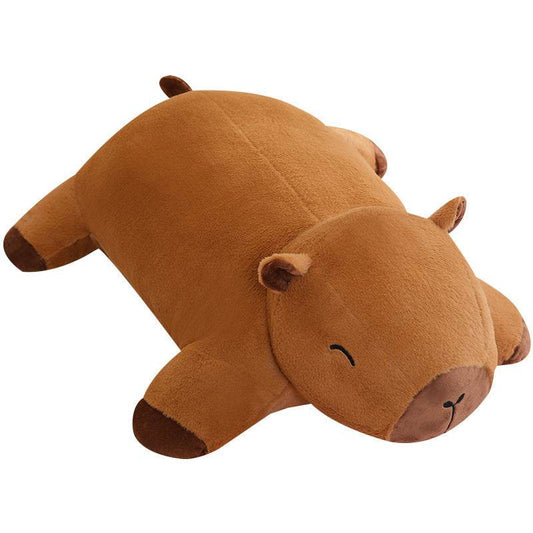Teddy Bears VS Real Bears
In the world of soft and huggable plushies, teddy bears hold a special place in our hearts. These furry, cuddly companions are adored by people of all ages, bringing comfort, joy, and a sense of security. However, there's an intriguing paradox surrounding these lovable teddies. Why do we consider teddy bears cute when, in reality, their real-life counterparts, wild bears, are fierce and powerful creatures? Let's embark on a journey to unravel the complex interplay of history, storytelling, and psychology that explains this paradox.
The Origin of Teddy Bears

Teddy bears, with their button eyes and soft fur, have been charming people for over a century. The story begins with Theodore Roosevelt, the 26th President of the United States, who once had a remarkable encounter with a bear. It's this story that gave birth to the term "teddy bear."
Theodore Roosevelt was on a hunting trip in Mississippi, and his companions had managed to capture a bear. Seeing that the bear was helpless and tied up, Roosevelt refused to shoot it, displaying an act of compassion and sportsmanship. The incident was caricatured by Clifford Berryman in The Washington Post, and this inspired Morris Michtom, a toymaker, to create a stuffed bear he named "Teddy's Bear."
Why DO Kids and Adults Love Teddy Bears?
Teddy bears have become iconic symbols of comfort, love, and childhood. Their charm lies in their adorable appearance, reminiscent of innocence and security. Here's why teddy bears are considered cute:
1. Soft and Cuddly Texture
Teddy bears are made from plush materials that are incredibly soft to touch. They invite you to snuggle and provide comfort, just like a warm hug from a loved one.
2. Endearing Facial Features
The round faces, button eyes, and stitched smiles of teddy bears make them appear perpetually happy and friendly. These features trigger positive emotions and warm feelings.
3. Compact Size
Their manageable size and lightweight nature make them easy to carry around, creating a sense of companionship and ease of bonding for both children and adults.
4. Versatile Expressions
Teddy bears come in a variety of colors, sizes, and styles, allowing people to choose the one that resonates with their personal preferences and emotions.
5. Sentimental Value
Many people have received teddy bears as gifts, making them symbolic of love, friendship, and cherished memories.
Teddy bears have an innate ability to evoke tenderness and affection, and their role in providing comfort and companionship cannot be overstated.
The Power of Storytelling:
The stories we tell have a profound impact on our perceptions and, indeed, our world. The tale of Teddy Roosevelt and the bear in Mississippi serves as an allegory for our broader relationship with wildlife. It highlights our capacity to shape our understanding and emotions towards animals. The legend of Teddy Roosevelt, this extraordinary act of compassion towards a bear, and the subsequent creation of the teddy bear, underscore the ecological responsibility society holds for the preservation and conservation of wildlife. This power of storytelling plays a crucial role in how we perceive animals, as our collective imagination becomes an influential force in shaping the world around us
Real Bears:
Contrasting the cuddly image of teddy bears, real bears are indeed fierce and formidable wild creatures. They are apex predators, known for their strength and adaptability. However, it's essential to recognize that bears are not inherently aggressive toward humans and are more likely to avoid confrontation if possible. Here are some important facts about real bears:
- Bear Attacks Are Rare: According to the National Park Service, the chances of being injured by a bear in a national park are exceptionally low, with an estimated likelihood of approximately 1 in 2.1 million park visits.
- Ecosystem Stewards: Bears play a critical role in ecosystems as seed dispersers and nutrient recyclers. They help maintain the balance of various animal populations by controlling their numbers.
- Remarkable Intelligence: Bears are intelligent animals, known for their ability to use tools and solve problems. Their problem-solving skills are often considered among the best in the animal kingdom.
In conclusion, the paradox between the perception of teddy bears as cute and real bears as fierce wild creatures is a testament to the power of storytelling and human imagination. The history of the teddy bear, its association with Teddy Roosevelt's compassionate act, and the urbanization of American society have shaped our view of these animals. On the other hand, real bears are essential components of ecosystems, characterized by their intelligence and rarity in bear-human encounters. Understanding this duality helps us appreciate the complex relationship we have with both the fictional and real bear worlds. It underscores the profound impact of our stories on our perception of the animal kingdom and our responsibility in conserving and preserving the wild.
In a world where the boundaries between reality and imagination often blur, teddy bears remain a testament to our ability to shape and reimagine the world around us through the stories we tell and the compassion we extend to nature.
















